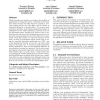Free Online Productivity Tools
i2Speak
i2Symbol
i2OCR
iTex2Img
iWeb2Print
iWeb2Shot
i2Type
iPdf2Split
iPdf2Merge
i2Bopomofo
i2Arabic
i2Style
i2Image
i2PDF
iLatex2Rtf
Sci2ools
AVI
2006
2006
Usability of overview-supported zooming on small screens with regard to individual differences in spatial ability
While zoomable user interfaces can improve the usability of applications by easing data access, a drawback is that some users tend to become lost after they have zoomed in. Previous studies indicate that this effect could be related to individual differences in spatial ability. To overcome such orientation problems, many desktop applications feature an additional overview window showing a miniature of the entire information space. Small devices, however, have a very limited screen real estate and incorporating an overview window often means pruning the size of the detail view considerably. Given this context, we report the results of a user study in which 24 participants solved search tasks by using two zoomable scatterplot applications on a PDA - one of the applications featured an overview, the other relied solely on the detail view. In contrast to similar studies for desktop applications, there was no significant difference in user preference between the interfaces. On the other ha...
| Added | 30 Oct 2010 |
| Updated | 30 Oct 2010 |
| Type | Conference |
| Year | 2006 |
| Where | AVI |
| Authors | Thorsten Büring, Jens Gerken, Harald Reiterer |
Comments (0)

